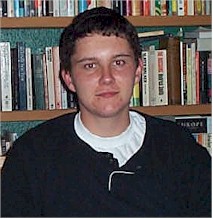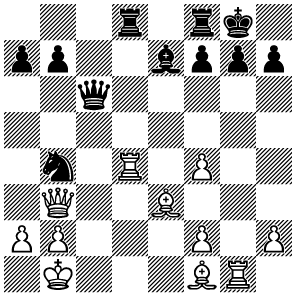Book Reviews by Sam Collins
 As I’m writing this on the opening day of the Ponomariov-Ivanchuk world championship match, I feel that Excelling at Chess (Everyman Chess, 190 pages, £16.99) by Danish IM Jacob Aagaard will be of interest to even more chess players than usual. As we watch the Ukrainian giants battle for one of the highest honours in chess, it is natural to ask ourselves how we can best improve our own games, and Aagaard makes a very interesting attempt to answer this question. As I’m writing this on the opening day of the Ponomariov-Ivanchuk world championship match, I feel that Excelling at Chess (Everyman Chess, 190 pages, £16.99) by Danish IM Jacob Aagaard will be of interest to even more chess players than usual. As we watch the Ukrainian giants battle for one of the highest honours in chess, it is natural to ask ourselves how we can best improve our own games, and Aagaard makes a very interesting attempt to answer this question.
Those of you familiar with Aagaard’s previous work will have noticed that it centered around the opening (The Dutch Stonewall, Sicilian Kalshnikov and Easy Guide to the Panov-Botvinnik Attack, to name but a few). Excelling at Chess is Aagaard’s first attempt to provide a general guide to chess improvement, and an excellent guide it is too.
The book is the medium through which Aagaard discusses his theory of chess improvement. In his opening chapters, ‘Think Like a Human - and Excel at Chess’ and ‘Real Chess Players’, he suggests, amongst other things, that calculation is overrated in modern chess. Aagaard believes that the so-called ‘Real Chess Players’ (‘someone who knows where the pieces belong’; according to Kasparov, there are only a handful of such players), such as Kasparov, Kramnik and Anand, are superior not by virtue of their calculating ability but rather because of their positional understanding. In his analysis of Kasparov’s games, for instance, Aagaard points out that it is the Grandmaster’s iron logic which gives him the edge, since Kasparov knows what he should be trying to do, and finds the tactics to do it. There are some points at which I find his theory dubious - it is clear that Kasparov and Kramnik calculate more than almost anyone else, and perhaps it is their phenomenal visualisation powers and tactical instincts which enable them to do so with precision, rather than a simple superiority of logic - but it is a refreshing new perspective into modern chess.
Aagaard’s next chapter, ‘No Rules?’, is probably the most interesting in the book. Here is the first rebellion I have seen against the universally embraced theory of ‘Rule-Independence’, as developed by fantastic books such as Suba’s Dynamic Chess Strategy and Watson’s Secrets of Modern Chess Strategy. Aagaard strongly argues that chess is based on rules (“knights on the rim are dim&rdquo, “bishops beat knights in open positions”, “rooks behind passed pawns” and so on), and it is the logical analysis of the interaction of these rules that will enable players to get to the heart of chess positions. Aagaard criticises Watson’s views, and annotates several games (used by Watson as examples of the inapplicability of general rules) by showing the logical basis for a player’s decisions. While he slightly misses Watson’s point, he still presents interesting arguments. He discusses elements (real features of positions - weaknesses, passed pawns, open files, etc.) and concepts (ideas we would like to play - improving our knight, setting up a blockade, exchanging off minor pieces to get a good knight vs. bad bishop endgame and so forth), global and local rules (how individual positional factors affect the validity of general rules), and the technique of comparing pieces. This is all rather difficult to describe, so I’ll let Mr. Aagaard say a few words:
1 e4 c6 2 d4 d5 3 exd5 cxd5 4 c4 Nf6 5 Nc3 Nc6 6 Nf3 Bg4 7 cxd5 Nxd5 8 Qb3 Bxf3 9 gxf3 Nb6 10 Be3 e6 11 0-0-0 Be7 12 d5 exd5 13 Nxd5 Nxd5 14 Rxd5 Qc7 15 Kb1 0-0 16 f4 Nb4 17 Rd4 Qc6? 18 Rg1 Rad8 (D)
Acs-Ruck, Hungary 1996, White to play

“Let us start with comparing the pieces. The kings seem to be more or less equal. White has some pressure on the g-file and Black has potential pressure on the e4-b1 diagonal. Actually, Black threatens ...Rxd4 followed by ...Qe4+. This is what made Brynell (who had this position in an earlier game - Collins) play the awful 19 Rc4? and end up in a poor position that he won in thirty moves. It is hard to see a difference between the kings, but there is one when we come to the queens. White’s queen is posted on practically the best square, monitoring the key squares d5, b7 and f7 and assisting the attack on Black’s knight. The black queen is also well placed, but not permanently since it can easily be challenged by Bg2 at any moment. In fact it is not easy to see where the queen should find a long-term resting place, so this is a positional problem for Black. The rooks on d4 and d8 appear to be of equal strength; I like the pressure White’s exerts on b4, but I also like the potential pressure on the d-file. As for the other rooks, White’s is aggressively posted on the g-file and is clearly superior to Black’s, which does nothing on f8 and is yet to find a decent role. The dark-squared bishops are evenly matched, and it is a case of which will occupy the long diagonal first (at the moment it looks like Black, but nothing is decided yet). I prefer White’s light-squared bishop to the knight (despite the fact that it is not well placed at the moment) in view of the respective long-term prospects of the pieces. Both b7 and f7 are major weaknesses and Black cannot find a safe spot for the knight in this open centre. Actually this is a powerful example of a bishop being superior to a knight in an open position. The bishop can move freely and the knight has nowhere to go.
“Had Brynell carried out this brief exercise (he was busy worrying about Black’s threat) he would have been more optimistic, although I know that Brynell would have been careful nonetheless. It is my conclusion that White stands better and should play aggressively. The best way to put pressure on the opponent before you strike is to improve your worst placed piece, and we already know that this is the light squared bishop. So we ask ourselves: at Christmas where would we want our light squared bishop? The answers are e4 or d5, central squares from where the bishop can concentrate on different weaknesses in the enemy camp. But how do we engineer this? Brynell wanted to play 19 Bg2 but noticed the seemingly deadly check 19...Qg6+, after which 20 Be4 loses to 20...Qxg1+. Note that 19 Bd3 allows an exchange of a great bishop for what we have already discovered is Black’s worst piece. Thus Black’s threat and 19 Bg2 Qg6+ prompted Brynell to opt for 19 Rc4?, but this is the wrong attitude. We can see that 19 Bg2 is the correct move from our logical assumptions, so we should try harder to make it work - as do the best players. So, I quickly came up with...
19 Bg2!! Qg6+ 20 f5!
“This is not so difficult to find but, alas, was overlooked by Brynell. In fact this is Brynell’s great weakness. He is a very careful player who dislikes sacrificing material without immediate gain and is not too fond of lengthy calculations. Consequently a tactic such as the text might be lost on him. I guess that is why he will not become world champion.
20...Qxf5+ 21 Be4
“One of the ideal squares for the bishop.”
Aagard draws extensively on his knowledge of psychology throughout the book, particularly in the chapter ‘Attitude at the Board and Other Tips’, where he touches on aspects of physical and mental conditioning which, he believes, are essential for success. I enjoyed his honesty here... he is clearly writing from the perspective of a player who tried and failed to gain the Grandmaster title, and he is candid in his explanations of his own mistakes. While such an ambitious project from a player rated FIDE 2356 may normally be met with some scepticism (we would generally be much more receptive to a top player’s account of how top players think), this unique perspective gives the book much of its charm. Aagaard’s views, while controversial, are always interesting. His chapter ‘Why Study the Endgame’, for instance, really made me think about endgames differently by showing the (sometimes appalling) mistakes of top players in the most basic positions. His proposed method of studying openings is also thought provoking.
Indeed, this is the best adjective I can find to describe this book: thought provoking. It is packed with interesting and original material, and many of Aagaard’s suggestions seem to make excellent sense. It is sometimes difficult to follow Aagaard’s train of thought (several spelling and typographical errors don’t help), but if the reader perseveres he can make sense of all of the concepts presented here. All in all, a gem of a book, and one I highly recommend.
My Assessment (with 5 stars being the highest mark): * * * * *
Other reviews by Sam Collins
Review 1: Play the Open Games as Black, by John Emms
Review 2: The Human Comedy of Chess: A Grandmaster’s Chronicles by GM Hans Ree & Storming the Barricades by GM Larry Christiansen
Review 3: Open Ruy Lopez by Glenn Flear
Review 4: Main Line Caro-Kann by Neil McDonald
Review 5: Offbeat Spanish by Glenn Flear
Review 6: Excelling at Chess by Jacob Aagard
Review 7: Can You Be a Positional Chess Genius? by Angus Dunnington
Review 8: The Grunfeld Defence by Nigel Davies
Review 9: The Best of Chess Cafe
Review 10: How To Build Your Chess Opening Repertoire by Steve Giddins
Review 11: The …a6 Slav by Glenn Flear
Review 12: Starting Out: The Ruy Lopez by John Shaw
Review 13: Knockout Nimzo (video) by Tony Kosten
Review 14: My Great Predecessors by Gary Kasparov
|


